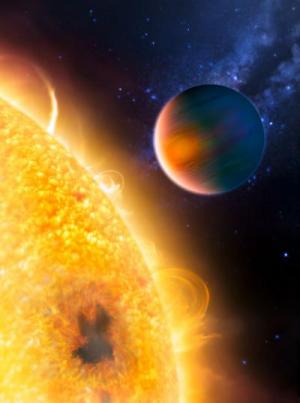For the first time Hubble discovered methane on a planet 63 light years away from Earth, the finding strengthens the claim that life can also exist elsewhere in the galaxy

The Hubble Space Telescope has for the first time discovered organic molecules in the atmosphere of a planet orbiting a star outside the solar system. The molecule found by Hubble is a methane molecule, which under certain conditions can play a key role in creating the conditions for the existence of life and is one of the basic elements in the existence of life on Earth.
The discovery proves that space telescopes can detect signatures of various molecules on planets that are light years from Earth. Hubble uses the technique of examining the spectroscopy of the reflected infrared light, that is, analyzing the light into its components to identify the materials from which the light is reflected.
Planet HD 189733b is a massive, Jupiter-sized planet orbiting a yellow dwarf (known as HD 189733A), located in the constellation The Fox. It orbits its star every two days and because of its proximity to the star, the intense heat on its surface temperatures reach 900 degrees Celsius, a temperature at which silver molecules resonate. It is likely that these conditions do not allow him to live life as we know it.
Although we have not discovered life, the development of new techniques for analyzing the composition of the atmospheres of distant planets brings us closer to the goal. In previous observations made by the Spitzer Space Telescope, scientists were able to detect signatures of water molecules in the planet's atmosphere. Now, Hubble has identified methane molecules. Researchers believe that there are other molecules, but they are below the clouds and therefore the reflected light does not contain their signatures.
It should be noted that after Spitzer's observations, a complex analysis of the star was performed, and its composition was determined according to the best accepted models, but Hubble's findings indicate that the composition of the atmosphere is different from what was initially assumed and that it contains much more methane than the conventional models yielded - which indicates that that we do not know much about the atmospheres of distant stars.
The measurements are an important step in achieving the final goal of determining the conditions prevailing on various bodies. The information we want to receive includes atmospheric pressure, winds, atmosphere, etc... Chemical composition can give indications of the existence of life, therefore the use of spectroscopy is key in these measurements and it can help locate and analyze the molecules that make up the planet.
As mentioned, we did not discover green creatures waving goodbye to us, but the continued development of the technique will help in later stages to examine other planets in colder regions where there are temperatures suitable for the existence of life and with a higher probability of finding life.
Hubble Space Telescope press release
The Spitzer Space Telescope was able to "see" and "smell" distant planets

7 תגובות
Let's say we find aliens and want to communicate with them, won't it take several hundred years for our transmitter to reach them?
Here is the link to the Kepler mission:
http://kepler.nasa.gov/
Take off on February 16, 2009.
H the first, in 2009 or 2010 a new spacecraft is supposed to take off into space, its purpose is to discover planets outside the solar system. The dramatic development is in the size of the detectable planets. The telescope is so powerful that it can "see" planets the size of Earth and even smaller. Maybe in the near future I will write an extended article about it.
Where is this star from?
That's it, Rami, I see the developments and I know that this is an order of magnitude that is already visible on the horizon and it's fascinating... let the technology come already... 🙂
We are only at the beginning of the research in the field of detection of planets outside the solar system, I compare it to the first years of the development of the telescope. I am sure that in time we will develop better techniques for detecting smaller planets.
Nice, and again the problem is precisely the size - to detect chemical composition, or the existence of a planet - they still mainly detect Jupiter-sized stars.
And if there is a small or huge amount of methane in it to detect, I don't know..